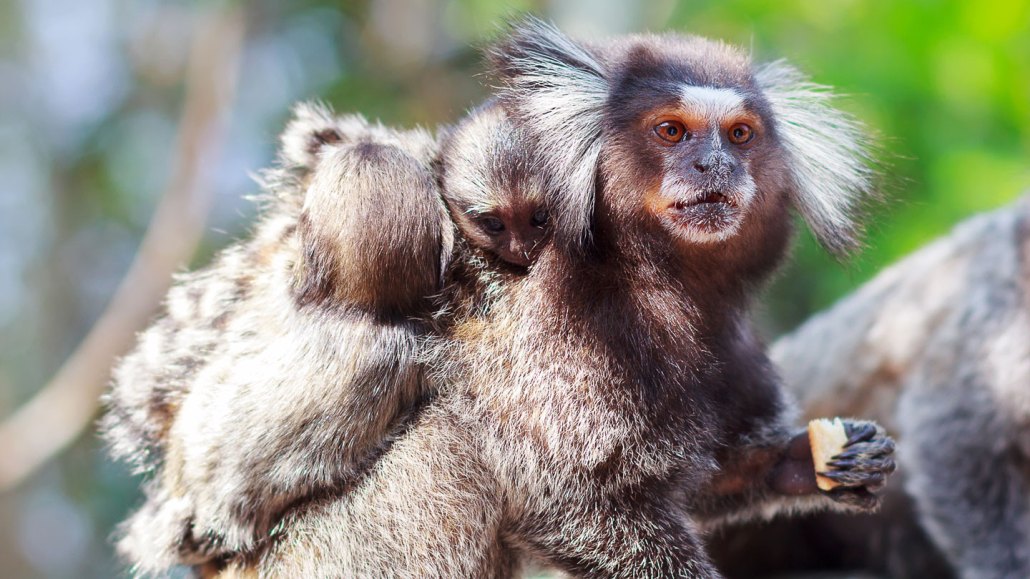
Baby marmoset monkeys, like the ones shown here, are born knowing how to cry. Ultrasound videos suggest they start practicing the motions in utero.
jantroyka/iStock/Getty Images Plus
Cradled inside the hushed world of the womb, fetuses might be preparing to come out howling.
In the same way newborn humans can cry as soon as they’re born, common marmoset monkeys (Callithrix jacchus) produce contact calls to seek attention from their caregivers. Those vocalizations are not improv, researchers report in a preprint posted April 14 at bioRxiv. Ultrasound imaging of marmoset fetuses reveals that their mouths are already mimicking the distinctive pattern of movements used to emit their first calls, long before the production of sound.
Early behaviors in infants are commonly described as “innate” or “hard-wired,” but a team at Princeton University wondered how exactly those behaviors develop. How does a baby know how to cry as soon as it’s born?
The secret may lie in what’s happening before birth. “People tend to ignore the fetal period,” says Darshana Narayanan, a behavioral neuroscientist who did the research while at Princeton University. “They just think that it’s like the baby’s just vegetating and waiting to be born…. [But] that’s where many things begin.”
Sign up for our newsletter
We summarize the week's scientific breakthroughs every Thursday.
Research shows, for instance, that chicks inside their eggs are already learning to identify their species’ call (SN: 9/16/21). “So much is developing so much earlier in development than we previously thought,” says developmental psychobiologist Samantha Carouso-Peck, executive director of Grassland Bird Trust in Fort Edward, N.Y., who was not involved in the research. But, she says, “we really haven’t looked much at all at the production side of this. Most of what we know is the auditory side.” Carouso-Peck studies vocal learning in songbirds and how it applies to how humans acquire language.
Narayanan and colleagues turned to marmosets because vocalization development in the monkeys is similar to that of humans (SN: 8/13/15). Two-person teams performed noninvasive ultrasounds on two marmosets nearly every day during four different pregnancies. The effort involved a lot of marshmallow fluff, Narayanan says. “They would do anything for marshmallows.”
Around 95 days into the pregnancy, a fetus’s face comes into view for the first time. The researchers observed that each young fetus moved its mouth and other parts of its face in tandem with its head. As the pregnancy progressed, the facial features and head began to move independently. The decoupling of these different motor regions presumably prepares the fetus for tasks like feeding or vocalizing.
Then it was a matter of reading lips. Was the fetus just moving its mouth, or were the movements mimicking particular sounds? It was clear to the researchers early on that the mouth movements were similar to the motions a marmoset makes during a contact call, distinct for its long duration and multiple syllables.
“The contact call is so unique that you really can’t mistake it for any of the other calls,” says Princeton biologist Asif Ghazanfar.
But to confirm, Ghazanfar, Narayanan and their team tracked the fetal jaw movements frame-by-frame to determine their duration. They also measured the number of “syllables” a fetus makes by calculating the number of movements separated by less than 500 milliseconds. The researchers then compared the fetal movements to the contact calls produced by the infant marmosets after birth. As the fetus approaches birth, its facial and mouth movements became increasingly similar to those of the infant contact calls — evidence, the team says, that the fetus is developing the ability to make this call after birth.
This supports the idea that early cries aren’t “magically appearing,” Narayanan says. “They have a long period of development — but in utero.”





